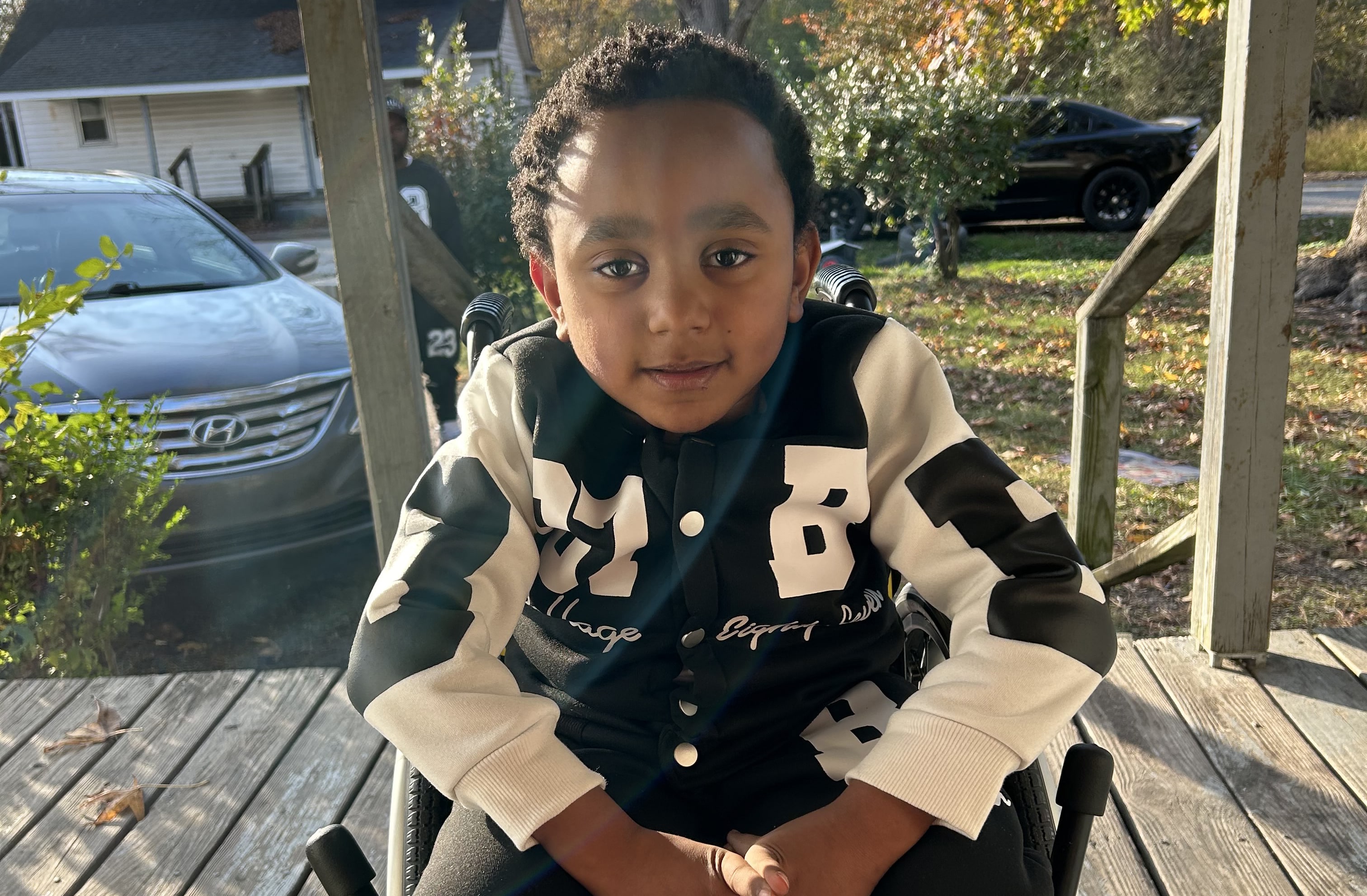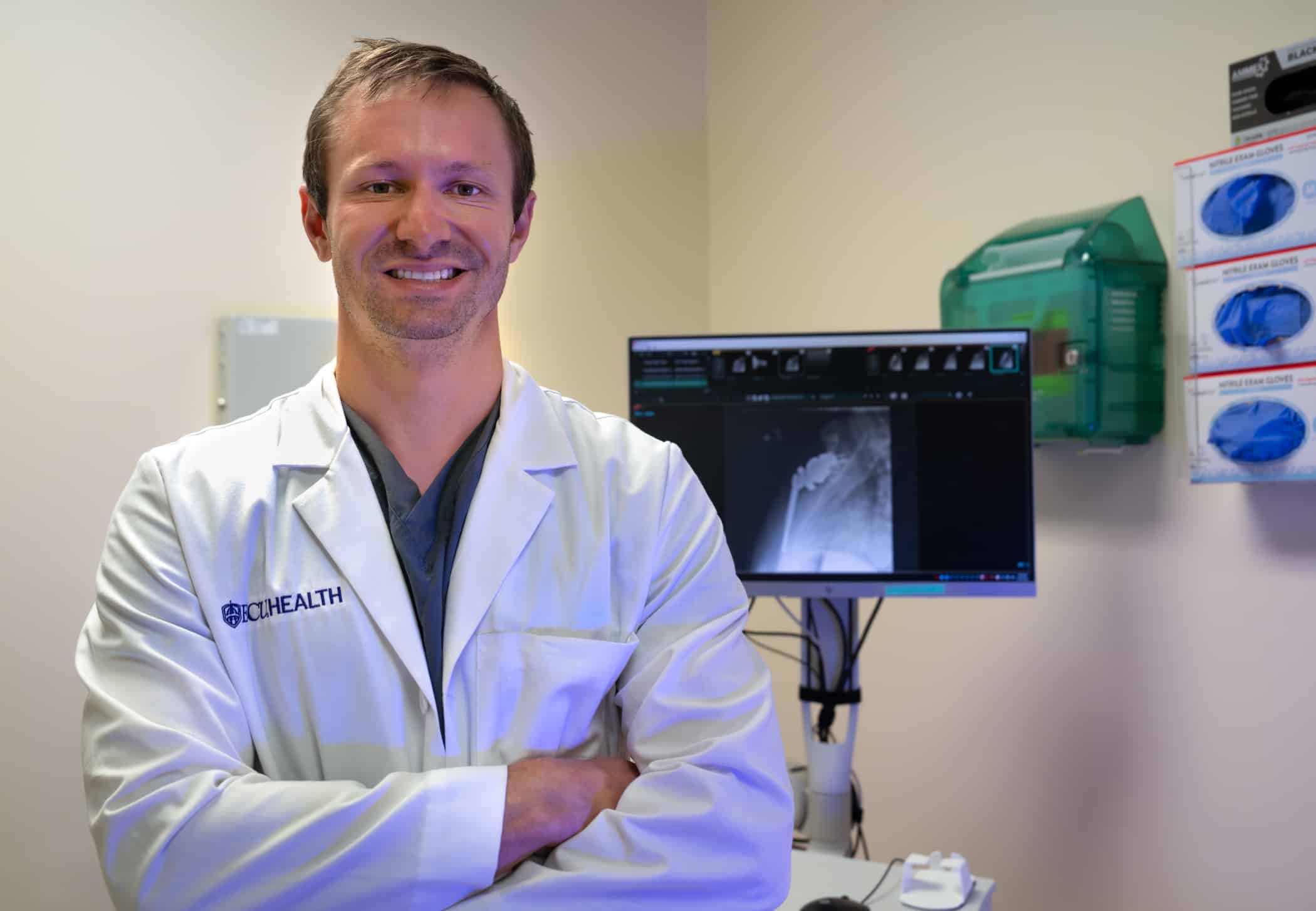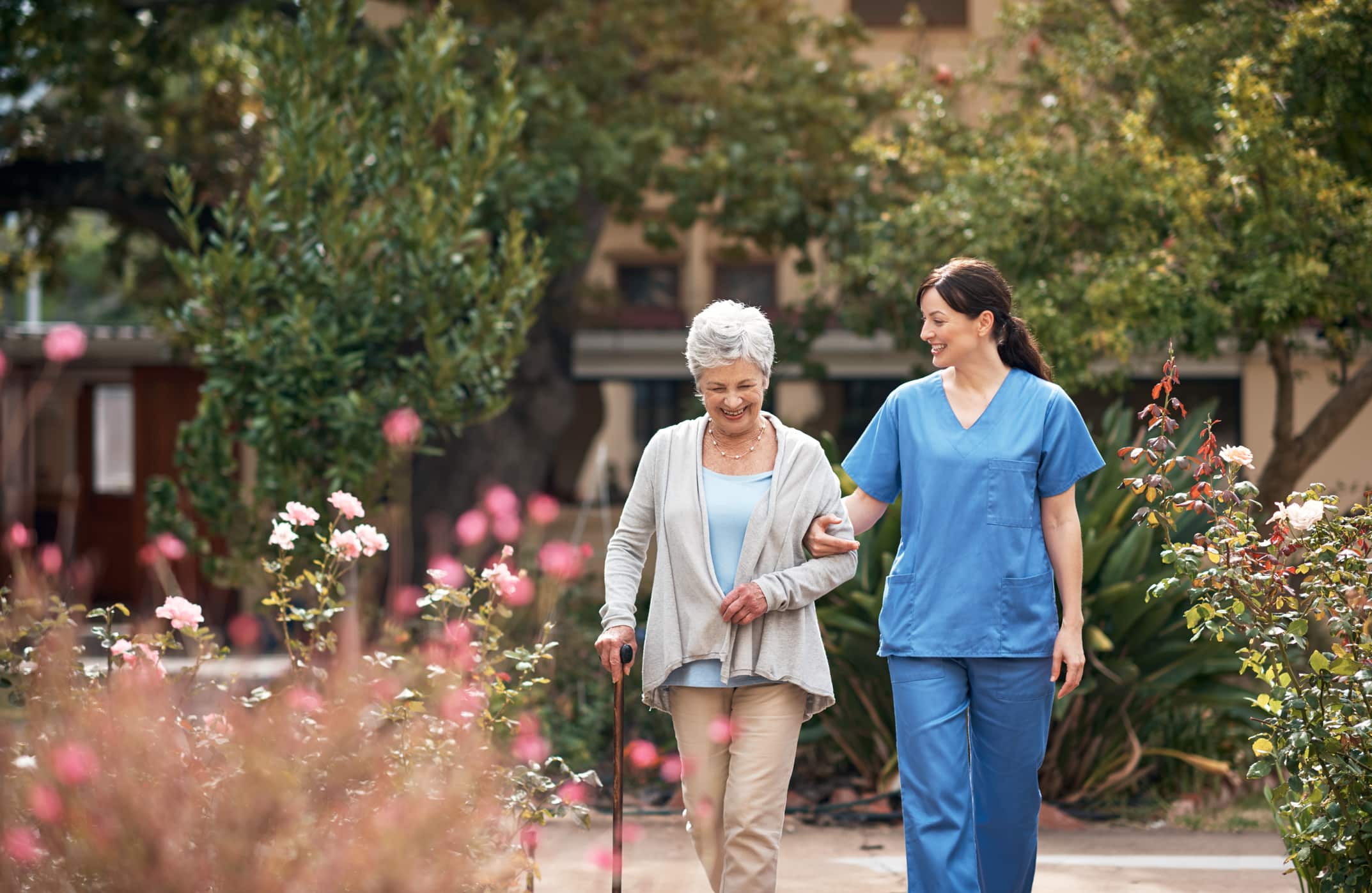Joshua Thomas, a lively and spirited seven-year-old, has never let his severe form of Osteogenesis Imperfecta (OI), commonly known as brittle bone disease, dampen his spirit or excitement for life.
“Joshua is full of life,” said his mother, Shakeema Thomas. “Even with everything he’s been through, he’s very active.”
Brittle bone disease is rare, impacting about 25,000 to 50,000 people in the United States, according to the National Institute of Health. The genetic disorder means Joshua’s bones are fragile and prone to frequent fractures. Over the years, Joshua has experienced a series of challenges, including approximately ten femur fractures, often from falling or seemingly harmless movements like repositioning in bed.
According to Shakeema, Joshua has broken the same femur bone about ten times. When Joshua sustained yet another displaced femur fracture, his family turned to Dr. Michael Firtha, a pediatric orthopedic surgeon at ECU Health who has treated both Joshua and his fifteen-year-old brother—who also has OI—for multiple fractures over the years.
“Displaced femur fractures in kids with osteogenesis imperfecta are difficult problems with limited options,” said Dr. Firtha. “You have to consider fixing the bone, allowing continued growth and preventing future fractures in the same area.”
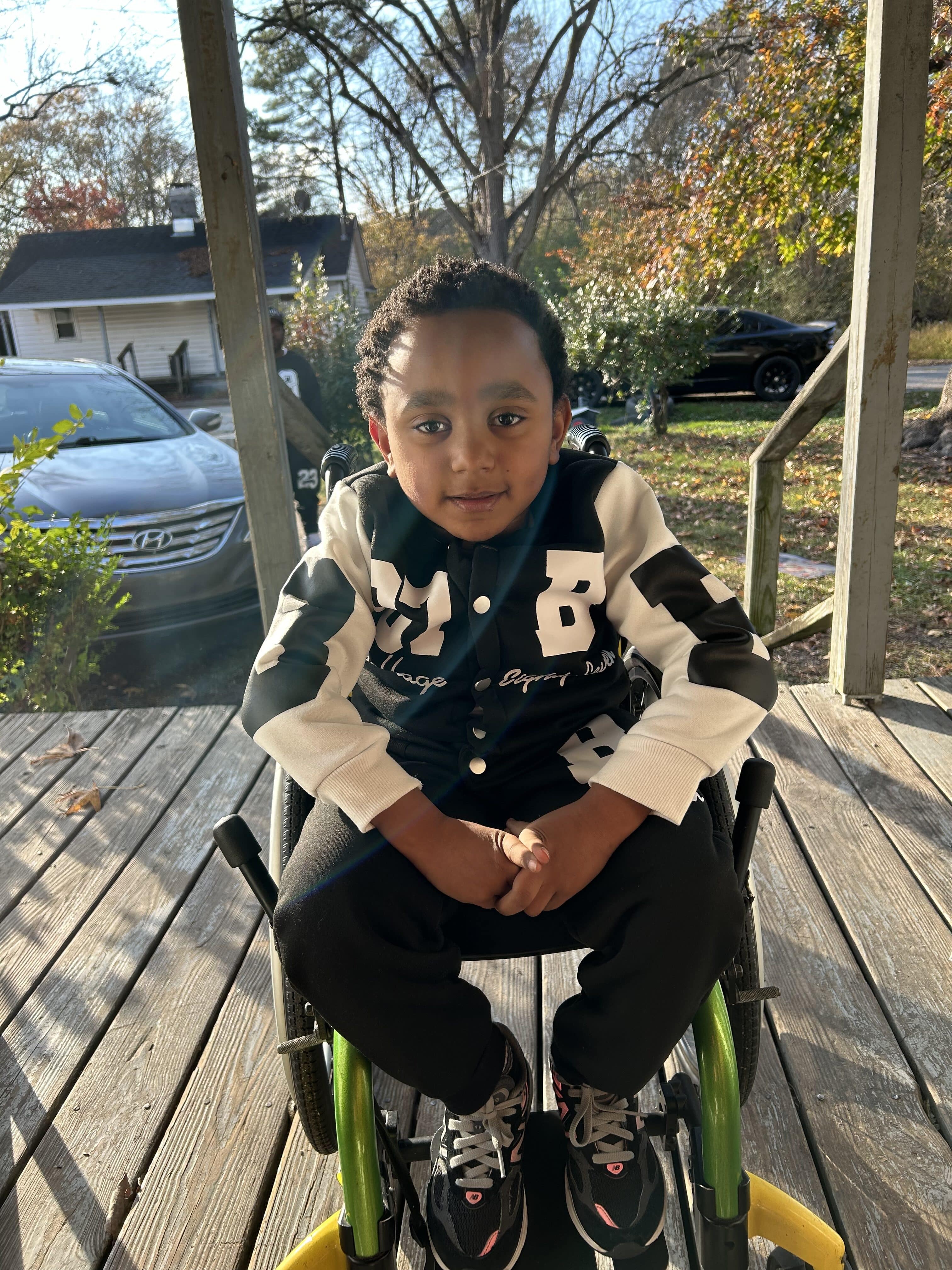
In the past, Joshua’s treatment included body and leg casts, but these approaches didn’t prevent recurring injuries. Determined to find a solution that worked better for Joshua, Dr. Firtha surgically implanted a telescoping metal rod, a procedure that was first-of-its-kind at ECU Health.
This innovative implant stabilizes the fractured bone while allowing it to grow naturally. As Joshua’s femur lengthens, the rod telescopes along with it, providing long-term protection without hindering development.
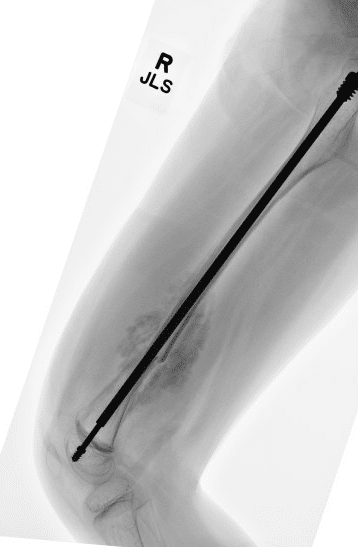
“This technology is a game-changer,” Dr. Firtha said. “It lets us fix the bone, promote healing and ensure Joshua’s growth isn’t compromised. I’m fortunate to work in a health system that prioritizes patient outcomes and embraces advanced technologies.”
The results have been transformative. Since the surgery, Joshua has had a few minor falls that would have previously resulted in fractures but did not this time. For Shakeema, the change is nothing short of remarkable.
“We’re so grateful for the care Joshua has received, and Dr. Firtha is so amazing,” Shakeema shared. “He’s doing well so far, and he’s completing physical therapy now every day to get stronger.”
Joshua’s story is a testament to the importance of advanced techniques and technologies that improve the quality of life to patients with rare and challenging conditions. To learn more about ECU Health Orthopedics, please visit ECUHealth.org/ortho.
Greenville, N.C. – Dr. Christoper Hasty, orthopedic surgeon with ECU Health and Orthopaedics East, performed the first BEAR® Implant to treat anterior cruciate ligament (ACL) tears at ECU Health on September 3. The implant enables a torn ACL to heal and restores the natural function of the knee, instead of replacing it with a graft.
“I’m proud to perform this innovative procedure in eastern North Carolina, offering patients a proven treatment option with the potential for less invasive surgery and easier recovery,” said Dr. Hasty. “The BEAR Implant represents a significant advancement in how we treat ACL tears by allowing the body to heal the ligament naturally, rather than relying on grafts. It’s an exciting step forward for our region, ensuring patients can access advanced orthopedic care close to home.”
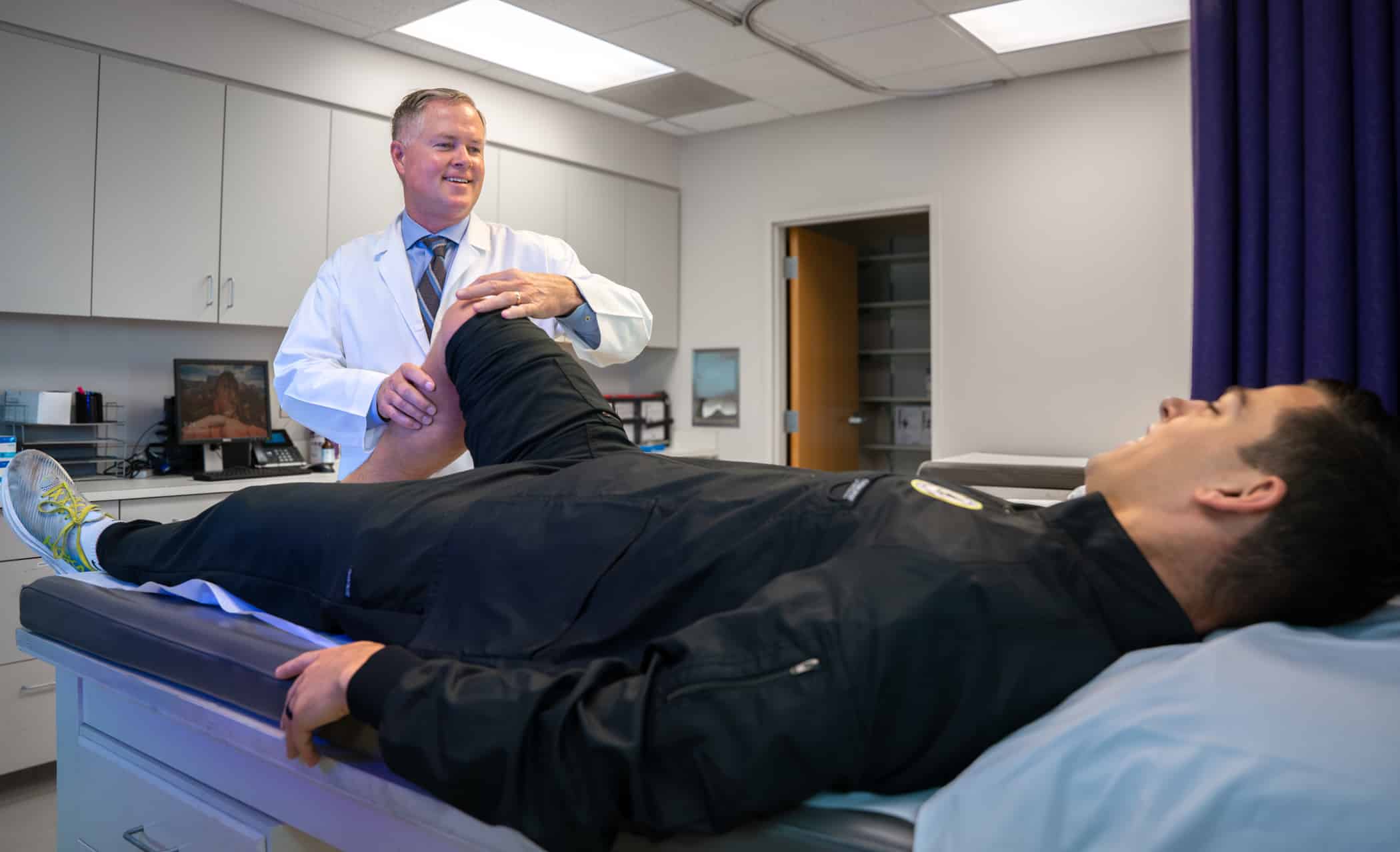
Every year, approximately 400,000 ACL injuries occur in the United States. A torn ACL does not heal without treatment, resulting in ACL reconstruction being one of the most common orthopedic procedures in the country. ECU Health performs about 150 ACL procedures each year in eastern North Carolina. Some procedures require two separate incisions, and some patients who undergo reconstruction are unable to return to the same level of daily activities or sports.
Unlike reconstruction, the BEAR Implant does not require a second surgical wound site to remove a healthy tendon from another part of the leg or the use of a donor tendon. The BEAR Implant acts as a bridge to help ends of the torn ACL heal together. The surgeon injects a small amount of the patient’s blood into the implant and attaches it between the torn ends of the ACL in a minimally invasive procedure. The combination of the BEAR Implant and the patient’s blood enables the body to heal the torn ends of the ACL back together while maintaining the ACL’s original attachments to the femur and tibia.
“We are excited by the work of Dr. Hasty and the care team providing cutting-edge orthopedic care right here in eastern North Carolina, where access to advanced treatments is critical for our rural communities,” said Jay Briley, president of ECU Health Medical Center. “Bringing new procedures like the BEAR Implant closer to home for our patients reduces the need for travel and ensures they receive the best care possible. This achievement highlights the dedication and collaboration of our team in providing world-class care to the communities we serve.”
Patients should discuss their individual symptoms, diagnosis and treatment with their provider. For more information about ECU Health Orthopedics and Sports Medicine, please visit: ecuhealth.org/ortho.
As part of its commitment to providing high-quality care to the people of eastern North Carolina, ECU Health now offers innovative advanced 3-D shoulder replacement surgery, providing a new solution for patients with complex shoulder joint damage. This cutting-edge procedure is designed to relieve pain and restore mobility for individuals suffering from conditions such as osteoarthritis, rotator cuff injuries and fractures.
According to Dr. Shawn Yeazell, ECU Health orthopedic surgeon, patients can sometimes have one or more shoulder replacements that failed or wore out, which leaves only a little bit of bone to work with, so traditional implants don’t work.
“We have an aging population, which is increasing the demand for orthopedic procedures like joint replacements,” said Dr. Yeazell. “We want our patients to live comfortably and to be able to do the things they love, so having the ability to provide complex procedures to relieve pain and joint immobility is crucial.”
Traditional shoulder replacement surgeries involve removing damaged bone and replacing it with standard metal and plastic parts. According to Dr. Yeazell, standard shoulder replacement parts work for most people who need a procedure. However, in cases where bone is missing or existing bone is poor quality, standard parts may not be sufficient.
“There’s a certain amount of bone that’s required for a traditional replacement,” said Dr. Yeazell. “The 3-D printed shoulder replacement surgery is a solution for those patients who would have no other option.”
The 3-D shoulder replacement process begins with doctors performing CT scans of the patient’s shoulder. These scans are then sent to an outside vendor, which creates 3D-printed joint replacements custom-fitted to the patient’s anatomy. This personalized approach allows orthopedists to perform surgeries with greater precision and effectiveness.

“Being able to perform cutting-edge procedures like 3-D joint replacement surgeries close to home is critical in caring for our region,” said Dr. Yeazell.
By offering 3-D shoulder replacement surgery, ECU Health is enhancing the quality of life for patients with complex shoulder conditions, ensuring they can continue to enjoy their daily activities pain-free. Dr. Yeazell is the first surgeon to bring the Zimmer Biomet 3-D custom Vault Reconstruction System (VRS) implant and associated technology to the ECU Health System.
To learn more about ECU Health’s orthopedic services, visit www.ecuhealth.org/ortho.
If you have experienced the pain, tingling or weakness that can occur with carpal tunnel syndrome, you are not alone. Carpal tunnel syndrome (CTS) is a fairly common condition which occurs when one of the major nerves to the hand, the median nerve which runs from the forearm into the palm of the hand, is squeezed or compressed as it travels through the wrist. Thankfully, what was once a complex treatment for CTS can now be accomplished more quickly and more effectively through new surgical interventions that reduce recovery times.
Milder symptoms of CTS can be treated with physician-directed home care, which may include wearing a wrist splint, avoiding daytime activities that may provoke symptoms, performing specific exercises and taking breaks from tasks to rest the hand. Medications may also be prescribed to relieve pain and inflammation.

In many cases, non-surgical treatments only provide temporary results, with symptoms eventually returning. Surgery typically becomes the recommended treatment option when this occurs.
“Carpal tunnel release surgery is one of my more common surgeries,” said Dr. Jeff Barwick, an orthopedic surgeon at ECU Health Beaufort Hospital, a campus of ECU Health Medical Center. “Traditionally, we would make an incision in the palm to access the tunnel and free the median nerve. The recovery would take anywhere from two weeks on the fast end to several months on the slow end. Also, during this recovery period, many patients would not be able to resume their normal activities using their hands due to pain and weakness.”
A modified procedure performed at ECU Health Beaufort called carpal tunnel release with UltraGuideCTR ™ can perform the surgery less invasively and with much quicker recovery time for the patient.
“Now, because of ultrasound guidance, we can essentially perform the same surgery but using a much smaller incision,” said Dr. Barwick. “We also come under the muscles of the hands instead of having to cut through them. The healing of the incision and the muscles has traditionally slowed down the recovery process. The ultrasound essentially serves as my eyes and allows me to see into the carpal tunnel with a very minimal incision. Having carpal tunnel release with UltraGuideCTR™ available at ECU Health Beaufort Hospital offers community members convenient access to the procedure and allows them to stay close to home. Patients can also enjoy a better quality of life. When people can’t enjoy life due to pain, numbness and weakness in the hands and wrists, this can be taxing to them mentally, emotionally and physically.”
Some of the benefits of this new technology include a faster recovery time as opposed to the weeks of recovery involved with traditional carpal tunnel surgery. Going underneath the muscles with a drastically smaller incision, rather than cutting, creates a more positive experience for patents and often times allows them to return to work and the activities they enjoy within three to six days.
According to Sonex Health, Dr. Barwick is the first physician in North Carolina to offer his patients both carpal tunnel release and trigger finger release with real-time ultrasound guidance. Providing this new and innovative technology for the local community is another example of ECU Health fulfilling its mission to improve the health and well-being of eastern North Carolina. For more information about carpal tunnel treatment options including the ultrasound assisted surgery, please call ECU Health Orthopedics – Washington at 252-946-6513.
A fall is any unintentional coming to rest on the floor or ground and anyone can be at risk, especially older people. The negative health impacts of falls increase dramatically at or above the age of 80, when a substantial number of fractures and spinal cord injuries can occur.
Statewide, statistics show the unfortunate impact of falls on North Carolina residents. Sarah Taylor, marketing manager for Vidant Health Home & Hospice and co-chair of The Eastern NC Falls Coalition, said many members of our community may not realize how serious falls can be.
Falls are the second leading cause of unintentional injury death for North Carolinians of all ages, and in every year from 1999 to 2019 it was the number one cause of injury death for individuals 65 and older. According to the National Institute on Aging, ever year 30 percent of people over the age of 65 will sustain a fall, of which 10 percent will result in serious injury.
However, there is good news. Falls are preventable and there are several proactive steps community members can take to avoid falls and their impact.
“There are several classes of medications that can cause an increased risk of falls, and though they can have an effect on patients of all ages, they can especially impact seniors age 65 and older,” Conrad Kirby, adult nurse practitioner with Vidant Internal Medicine said.
It is important to talk to your provider about the medications you take and what side effects could impact your balance and awareness.
As risks of falls increase with age, there are recommended ways to avoid them. Make sure your home is as safe as possible and create an environment that is conducive for your daily household activities. Some of the recommended steps to creating a safer home include the following:
- Have adequate lighting at night (nightlight in bathrooms)
- Have handrails/grab bars in bathrooms
- Clear pathways
- Maintain proper footwear
- Remove loose rugs
- Account for proper toilet seat height
“Pets are part of the family, but in terms of falls, pets can also be a danger to the safety of humans,” said Taylor. “It is crucial to keep them from getting entangled in your legs and causing a fall.”
According to the Center for Disease Control, it is estimated that more than 86,000 fall injuries are caused by pets. There are certain tasks you can perform that can protect both pets and the people who love them:
- Before hauling in groceries put your pet in a different room to eliminate trips and falls
- Leave a light on at night so pets can be seen when walking to the bathroom
- Teach the pet to sit when someone knocks or rings the doorbell.
- Purchase a reflective collar for the pet
- Discourage pets from lingering in the kitchen during meal preparation
- Teach the pet to stay at the top or bottom of the steps until everyone is off the stair case
“Keeping up with vision checks with your eye doctor is one of most important ways of staying ahead of potential falling risks,” Kirby said. “Also, regular physical activity, proper diet and avoidance of excessive alcohol use can help you stay safe and reduce your risk for injury.”
Glen Newman, a physical therapist for Vidant Health added, “Preventative measures like exercise can help strengthen the body. Certain exercises which help build strength and balance can help you avoid falls.”
It is recommended to do some strengthening exercises as least twice a week to maintain independence and coordination.
For more information about resources regarding falls prevention visit https://ncfallsprevention.org/ and to learn more about exercise and wellness services, visit https://www.ecuhealth.org/services/wellness-prevention/
With easing COVID-19 restrictions, we are on the move again, especially children and teens in sports. With that comes the potential for injury and Vidant Orthopedics and Sports Medicine is here to help.
Vidant Orthopedic surgeon Dr. Robert Palmer appeared on WITN to discuss common sports injuries and how to prevent them.
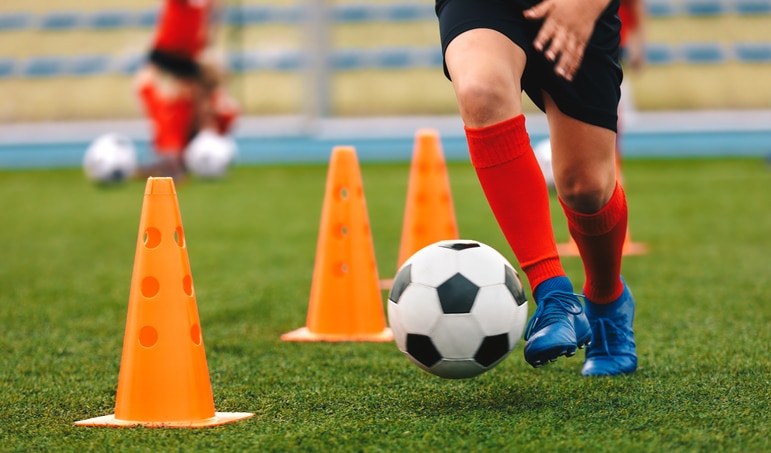
He said the most common sports-related injuries he sees are broken wrists and clavicle fractures. The most important things you can do for yourself or your child to prevent sports injuries is to maintain a typical healthy lifestyle and get plenty of Vitamin D.
Dr. Palmer said a unique risk this year is young people returning to sports after a year away.
“I’ve seen quite a number of children in my clinic who have gone back, and just participating in a field day event at school and they’ve actually gotten stress-related fractures from what we would consider everyday events,” Dr. Palmer said. “That is probably just because their bodies aren’t used to the load from sports. I think taking it slow and easing back into things and making sure they have a good healthy diet is a good start to prevent injuries.”
He also discussed the importance of the implementation of rules to limit overuse injuries. An example of this is rules set by youth baseball organizations in conjunction with Major League Baseball to keep children safe. Dr. Palmer encouraged coaches and parents to educate themselves on these rules and stay on top of them to keep children healthy.
While many sports-related injuries in children just require typical treatment like rest and ice, some are more serious. It can be challenging to know when it’s time to consult a physician but Dr. Palmer gave some tips on what to look for.
“When we see a patient, if they have limited range of motion, inability to weight bear, swelling about a joint, reduced motion about that joint,” Dr. Palmer said, “certainly if there’s a bone sticking out of the skin or there’s bleeding, those are more urgent things that we should address and potentially may need surgery. Other sports-related injuries are ACL tears or ligament tears and shoulder instability that we think about.”
Visit the Orthopedics and Sports Medicine section of VidantHealth.com to learn more about services Vidant offers.
